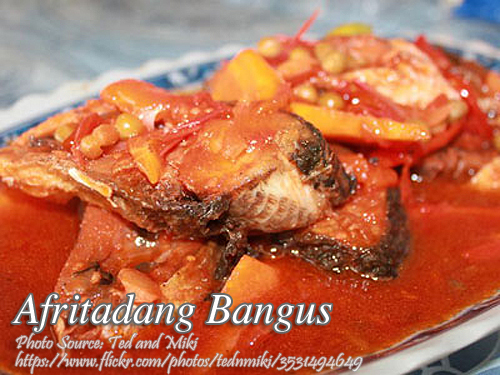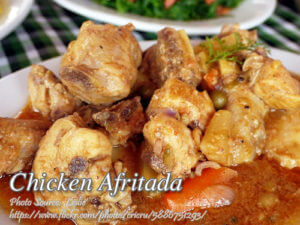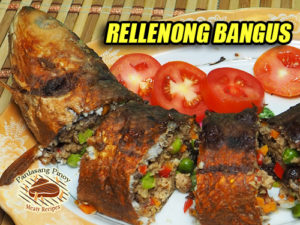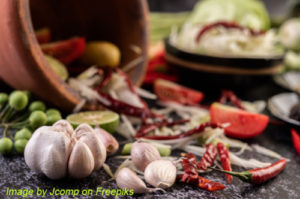Afritada dish is one of the well know Filipino dishes and the most common afritada is chicken afritada and it is cooked with tomato sauce, carrots, potatoes, green peas and bell peppers as the main ingredients. What I have here is a healthier version of afritada, instead of chicken, bangus is substituted.
Afritadang Bangus: A Healthier Twist on a Filipino Classic
Afritada is one of the most beloved dishes in Filipino cuisine. Traditionally made with chicken, it’s a comforting stew of tender meat simmered in a rich tomato sauce with vegetables like carrots, potatoes, and bell peppers. My version of this dish, however, brings a healthier twist by swapping out the chicken for bangus, or milkfish. This is something my Tito Boyet suggested one weekend when we were talking about finding ways to make our favorite dishes a bit lighter yet still delicious.
A Trip Down Memory Lane with Afritada
Afritada, like many Filipino dishes, is influenced by Spanish cuisine, particularly in its use of tomato-based sauces. It’s one of those meals that I distinctly remember from family gatherings, especially when my Lola Lydia would cook a giant pot of chicken afritada. The savory aroma of tomatoes and garlic would fill the air, and I remember helping her stir the pot while she told stories about how her own mother used to make it for her. What made it special wasn’t just the taste, but the memories and traditions tied to it.
Now, using bangus instead of chicken may not have been part of my Lola’s recipe, but my family always believed in making dishes their own. My sister, Ate Josie, would prepare her afritada with pork on special occasions. And so, when Tito Boyet suggested using bangus, I was intrigued. After all, bangus is such a versatile fish, beloved for its tender meat and slightly tangy flavor. It seemed like a natural pairing for the rich tomato sauce of afritada.
Why Bangus?
Bangus, or milkfish, is the national fish of the Philippines. Its distinct taste brings a unique twist to the traditional afritada. It’s rich in omega-3 fatty acids and packed with protein, making it a healthier alternative to the usual chicken or pork versions.
One of the challenges with bangus, though, is its bones. Growing up, my Nanay always told me to be careful when eating bangus, as it’s notoriously bony. But as I learned from her, there’s a trick to preparing it: make sure to clean it thoroughly, removing the internal organs and gills, and slice it into manageable pieces. I like to rub the fish with salt and let it sit for about 10 minutes. This helps not only with flavor but also ensures the skin stays intact during frying.
The Golden Fry: Why It Matters
Frying the bangus before adding it to the afritada is key to this recipe. My Tita Lina always said, “Pag hindi mo prinitong maayos, lalambot at maghihiwalay yung isda.” (If you don’t fry it properly, the fish will become mushy and fall apart.) When fried to a golden brown, the bangus develops a crisp exterior that holds up well when simmered in the sauce.
A little trick I learned from my brother Kuya Mark is to cover the pan while frying to avoid splattering oil, as bangus has a high moisture content and can cause quite the mess. Once the fish turns golden brown, I remove it from the oil and set it aside, knowing that its crispy skin will give the final dish a delightful contrast in texture.
Building Layers of Flavor
After frying the fish, I reuse the same pan, leaving just a tablespoon of oil to sauté the garlic, onions, and tomatoes. My Lola Lydia always believed that the flavor left behind from frying the fish adds an extra layer of depth to the sauce. The tomatoes, in particular, need to cook down for about two minutes until they release their juices and combine with the onions and garlic to form a fragrant base.
Once the sauté is ready, I pour in the tomato sauce and add the carrots and bell peppers. It’s important to let these simmer until the liquid reduces and thickens, as this helps the vegetables absorb all the delicious flavors. This step always reminds me of how my Ate Josie used to stand by the stove, stirring patiently, making sure everything was just right before moving on to the next step.
The Final Simmer
After the sauce has thickened, I add in the green peas and the fried bangus. The fish only needs to simmer for about half a minute, just long enough to warm through and let it soak up some of the sauce. Seasoning is crucial here. I use a bit of patis (fish sauce) for a salty kick, a pinch of ginisa mix for umami, and just a touch of sugar to balance out the acidity of the tomatoes.
When the dish is ready, the tender bangus is perfectly complemented by the slightly sweet and savory sauce. The carrots, bell peppers, and peas bring a wonderful freshness and color to the dish, making it not only delicious but visually appetizing as well.
A Healthy and Delicious Alternative
What I love most about afritadang bangus is that it’s a lighter version of the classic dish, yet it’s just as flavorful. The bangus gives it a unique taste, while still maintaining the comforting essence of the original afritada. It’s a dish I often make when I want something hearty yet healthy, and it always brings back fond memories of family meals and kitchen conversations with my loved ones.
Afritada may have started with chicken, but like all Filipino dishes, it’s open to interpretation and adaptation. My family has always believed that food is about more than just taste—it’s about bringing people together, sharing stories, and creating memories. And every time I make afritadang bangus, I feel like I’m continuing that tradition.
How to Cook Afritadang Bangus (Milkfish Afritada)
Ingredients
- 1 kilo bangus
- 2 pcs medium size tomatoes chopped
- 1 small can tomato sauce
- 1 pc medium size green and red bell pepper
- 1 can green peas or chick peas
- 1 tsp. sugar
- 3 cloves garlic minced
- 1 pc medium size onion chopped
- 2 pcs small potatoes sliced into quarters
- 1 pc carrot sliced
- cooking oil for frying
- 1 tsp. ginisa mix or magic sarap
- rock salt
- patis to taste
Instructions
How to cook afritadang bangus:
- Clean the bangus, remove the internal organs and gills. Slice the bangus into 4 to 5 pcs.
- Rub with salt and set aside for at least ten minutes.
- Fry the fish and cover the frying pan because oil has a tendency to splatter.
- When it turns golden brown, remove from oil and set aside.
- Fry the rest of the bangus until every fish is already fried.
- On the frying pan where you fried the bangus, remove the oil and transfer to a container and leave at least 1 tablespoon on the frying pan.
- Saute garlic, onion and tomatoes. Stir-fry for at least 2 minutes or until they are cooked.
- Then add the tomato sauce, carrots, bell pepper and simmer until the liquid evaporates or until the consistency is thick.
- Add the green peas and fried bangus and simmer for at least half a minute.
- Season with patis, ginisa mix and sugar and adjust the amount if necessary.
Notes
Cooking Tips:
Properly Fry the Bangus for a Crispy Exterior
When frying the bangus, ensure the oil is hot enough before adding the fish to achieve a golden, crispy exterior. Cover the pan to prevent oil splatters, as bangus tends to release moisture while frying. Frying the fish properly helps it hold its shape and texture when simmered in the sauce later.Let the Sauce Thicken for Maximum Flavor
Allow the tomato sauce and vegetables to simmer until the liquid reduces and thickens, enhancing the depth of flavor. This thick consistency helps the sauce coat the bangus and vegetables evenly. A well-reduced sauce also intensifies the taste, making every bite rich and savory.Add the Bangus Last to Prevent Overcooking
After frying, add the bangus to the tomato sauce just before serving to avoid overcooking it. Simmer for only half a minute to let the fish absorb the sauce while keeping its crispy texture. This method ensures the bangus remains firm and flavorful without becoming soggy.





